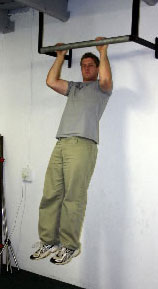|
The Pull-Up Row - A Unique Bodyweight Back Exercise
You Can Do Almost Anywhere
Bodyweight exercises are among the most effective exercises for building strength and muscle mass. However, for most trainers, the only bodyweight exercises for the back that they know are the pull-up or chin-up! While the pull-up is definitely effective, it can be too challenging for some or not challenging enough for others. Also, pull-ups don't fully address the different positions the back is capable of working in.
Enter the pull-up row. It gives all the significant benefits of a bodyweight exercise while actually improving on the regular barbell, dumbell and cable row by taking the lower back completely out of the movement.
 Today, you're going to learn four variations of the pull-up row that target the total beginner all the way to the very advanced.
Today, you're going to learn four variations of the pull-up row that target the total beginner all the way to the very advanced.
Note about rows: it's important with all rowing movements to keep your lower back arched. This position prevents injuries and helps put the lats in their best position for activation.
1. Beginner Level - Standing Pull-Up Rows
To perform the Standing Pull-Up Row, all you need is something solid to grab onto, like a pole or a railing. You can grab directly onto it or loop a towel around it, grasping the ends of the towel.
Set your feet close to the bottom of what you're holding onto and lean back to arms-length. Keep your entire body straight and stiff - the only movement will come at the elbows and shoulders.
Pull yourself up towards the pole, squeezing the muscles in your back hard. Lower yourself back down, letting your arms straighten out, and repeat.
As you get stronger with these, you can also do them holding on with only one arm and pulling up one arm at a time.
2. Beginner to Intermediate Level - Lying Pull-Up Rows
The Lying Pull-Up Row requires something solid that you can lay under and grab onto. It you're at home, this could be a very sturdy horizontal railing (be sure it's strong!). If you're at the gym, you can set a Smith Machine bar or power rack bar to a couple of feet off the ground.
Sit underneath the bar and grasp it with a shoulder-width, underhand grip.
Move your feet out and away, putting yourself into a laying position while holding onto the bar. Keeping your torso stiff, pull yourself up as though rowing.
The closer you keep your feet towards the bar, the easier the exercise will be. The easiest position for this version of the pull-up row is with your legs bent fully as though you are in the bottom of a squat. This greatly reduces the amount of bodyweight you must move.
To make the exercise harder, set your feet out further (or straighten your legs) or elevate your feet on a bench or chair. This will make you take up more of your bodyweight during the movement, increasing the resistance.
3. Intermediate to Advanced - One Arm Lying Pull-Up Rows
The set-up for the One Arm Lying Pull-Up Row is exactly the same as for the regular Lying Pull-Up Row as explained in the previous variation, the major difference being you'll grasp the bar with only one hand instead of two.
Grasp the bar with an underhand grip even with the centerline of your body for best balance and leverage. Pull up with the one arm for a full set then repeat with the other arm.
 You can hold your non-working arm across your abdomen or grip it onto the forearm of your working hand. Gripping your other arm with your non-working hand will make the exercise easier, however, as it will take up some of the resistance of the movement.
You can hold your non-working arm across your abdomen or grip it onto the forearm of your working hand. Gripping your other arm with your non-working hand will make the exercise easier, however, as it will take up some of the resistance of the movement.
4. Intermediate to
Advanced - Free Hanging Pull-Up Rows
This version of the Pull-Up Row will utilize all of your bodyweight for resistance, just like a chin-up. It can be done using a chin-up bar or, if necessary, using a Smith Machine bar or a bar set on the safety rails of a power rack.
If you have low ceilings, you'll need to use the power rack or Smith Machine version (set the bar to about 4 feet off the ground) otherwise your feet will hit the ceiling and stop the exercise.
Grasp the chin-up bar with a shoulder-width, underhand grip. Raise your legs up as though doing a complete hanging leg raise movement.
Lean your upper body back to a horizontal position and straighten your legs to vertical. Your shins should be right up against the bar and your feet should be directly above the bar. Your body should be in an "L" shape.
Holding your legs in that position, do a pull-up row from there. Keep your legs as close to the bar as possible when doing this to better keep your balance.
As you can see, the Pull-Up Row can be used effectively by every level of trainer from complete beginner to the very advanced. Give one of these versions a try in your next back workout!

More Articles by Author Nick Nilsson
Return To Weight Lifting Articles Archive
|